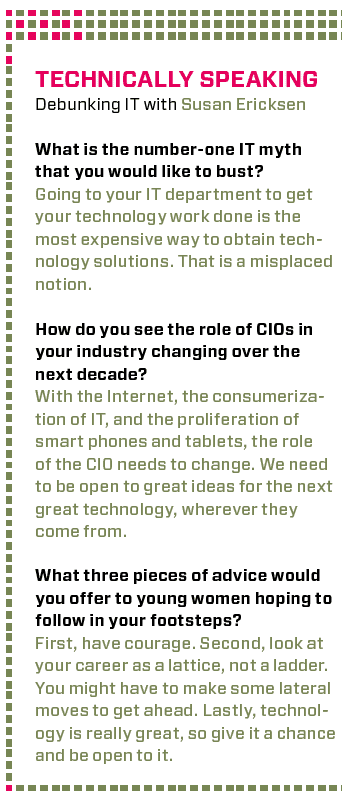Susan Ericksen stumbled into an IT career by accident. The Southern California native, whose passion leaned toward math and business, landed in a technology-training program after graduating from college and found that she also had a knack for IT. Good thing, too, because that job proved to be a springboard for high-profile positions at Qwest Communications, Citigroup Inc., Merrill Lynch, and, most recently, New York Life Insurance Company, which she joined in 2009 as senior vice president and chief technology officer. In September 2011, the life-insurance giant tapped Ericksen to be its CIO, making her responsible for the company’s technology strategy, including technology governance, infrastructure, networks, database administration, and application development and maintenance. It’s a big job—Ericksen leads a team of 900 employees and contractors—and one she loves.
You held important management and IT positions before joining New York Life. What things got you interested in pursuing the IT career track?
I fell into it. And once I started working in it, I discovered that I really enjoyed it, so I went back to school and got a master’s degree in computer science. I’ve always loved math, and in my job I always feel like I’m solving math problems. Before I became a manager, I looked at computer science as a way of solving problems. Sometimes I say it’s like doing a puzzle, so I’m fitting the pieces together to get a full picture. And since I became a manager, I found that leading technology professionals is even more rewarding.

You lead a large team at New York Life. What kind of management style do you have?
I like to describe myself as very direct and detail oriented. When I feel someone I’m speaking to has a handle on the details, I’m happy to let them take charge and own their own space. There are nine people who report directly to me, and they own their roles and responsibilities. I’ll give them guidance if I don’t think they have a handle on the details, and I’ll let them know that they need to pick up the pace and raise the bar.
Communication is really important. I’ve found that if you don’t communicate often, if people don’t know what’s going on, then rumors start. If the space isn’t filled with the facts, people will fill it with rumors. I hold regular staff meetings so I can communicate with people and let them know what’s happening, what the major initiatives are for this year, which groups and teams are doing things really well, and more to keep them informed.
Does your management style differ from that of your male counterparts?
Of the CIOs I’ve reported to prior to New York Life, I would say yes. My observation is that I communicated more. Here’s how I view my job: I’m a player on a basketball team, and I’m constantly telling the people around me if I have the ball; if I don’t have it, I explain where I am; and whether or not I can take a shot. The CIOs I’ve worked with in the past didn’t have that kind of communication style.
What are some of the key challenges and rewards you face as a female CIO?
There are challenges as a female CIO, but there are benefits, too. I belong to a couple of professional sharing groups, and when we’re meeting, I’m always aware of how many female CIOs are in the room. The percentage is still way too low for me. When I’m meeting with my peers at companies like State Farm or Shell, I feel that I’m adding value to the conversation by bringing interesting ideas to the table that maybe a roomful of men wouldn’t consider. Since I’ve always ignored barriers that are presented to me because I’m female, I’ve developed courage over the years. You have to be able to speak up for yourself and not be discouraged, and make sure you take advantage of all opportunities available in your career. You can’t let concerns about not being a man prevent you from raising your hand. This doesn’t apply just to women in IT; any leadership position takes courage.
And yet IT continues to be a largely male-dominated industry. Do you see that changing as more women pursue careers in technology?
I’m optimistic, but concerned. It’s not an issue at New York Life. In fact, I am the third female CIO in a row at New York Life. This is a very diverse and inclusive company, and half of New York Life’s employees are women. But the latest statistics out of colleges are disheartening with respect to the number of women getting into computer-science fields. Where are the women we can mentor and coach and sponsor? I’m an advocate for getting the best person for the job, but I’m also an advocate for bringing young women into the technology organization and giving them opportunities.
We need to place a very concerted focus on getting more women into technology, and that focus should start in middle school, emphasizing how much fun studying math and science can be. More women have the capacity to get into this field, so we need to get them young and show them how cool it really is.

